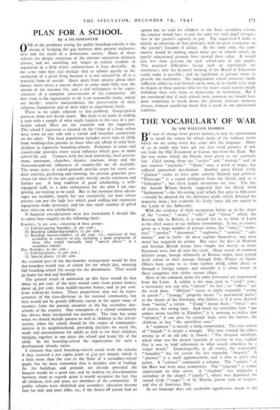PLAN FOR A SCHOOL
By A HEADMASTER
ONE of the problems vexing the public boarding-schools is the means of bridging the gap between their present exclusive-
ness and the needs of a democratic society. Many of these schools are deeply conscious of the present separation between classes, and are unwilling any longer to remain symbols of separation in a field where exclusiveness is least desirable. At the same time they feel strongly that to submit quietly to the extinction of a good thing because it is not enjoyed by all is a wasteful form of suicide. Quite apart from anxiety about their future, there exists a sincere desire to come more fully into the stream of the national life, and a real willingness to be repre- sentative of a complete cross-section of the community. All they want is the opportunity to do it on reasonable terms, which are briefly : relative independence, the preservation of their religious foundation and of their right to experiment freely. There is no single solution to this problem. Geographical position alone will decide much. But there is no harm in making a start with a sample of what might happen in the case of a par- ticular school. Here are the situation and the suggestion. The school I represent is situated on the fringe of a large urban area; town on one side and a varied and beautiful countryside on the other. The local population includes every type of child, from working-class parents to those who can afford to send their children to expensive boarding-schools. Proximity to town and countryside provides every social influence which goes to make school life Teal. Contacts with the local university, local govern- ment, museums, churches, theatre, cinemas, shops and the thousand-and-one influences of country-life are all available. The many acres of school-grounds provide scope for every out- door exercise, gardening and farming; the present generous pro- vision for most of the arts and crafts merely awaits extension and further use. A long tradition of good scholarship, a well- equipped staff, to a man enthusiastic for the plan I am sug- gesting, are waiting to be used. But at the moment these advan- tages are available, largely bte not exclusively, for boys whose parents can pay the high fees which good staffing and expensive equipment make necessary. and for that small number of gifted boys who can win scholarships.
If financial considerations were less formidable I should like to admit boys roughly on the following basis:
Boarders, 70 per cent.; consisting of three groups:
(a) Full-fee-paying boarders, 3o per cent.; (b) Boarding scholarship-holders, 55 per cent. ;
(c) Boarding bursary-holders, 25 per cent. (i.e., remission of fees according to capacity to pay, including a good proportion of
those who would normally hold special places " at a secondary school).
Day Boarders, 3o per cent.:
(a) Full-fee-payers, 15 per cent. ; (b) Special places, is per cent.
An essential part of the day-boarder arrangement would be that day-boarders would stay at school for the whole day, enjoying full boarding-school life except for the dormitories. They would go home for bed and breakfast.
The general result of admission on this basis would be that about 25 per cent. of the boys would come from poorer homes, about 45 per cent. from middle-income homes, and 3o per cent. from well-to-do homes. These proportions may not be repre-
sentative of the class-divisions in the national community, but they would not be greatly different, except in the upper range of incomes, from the present situation in the big secondary day- schools of the country. Our conception of a school community has always been interpreted too narrowly. The time has come when we should include parents as well as children in the school- society, when the school should be the centre of community- interest in its neighbourhood, providing facilities for social life, study and entertainment for adults as well as for their children, bringing together in one piece the school and home life of the child. In the boarding-school the organisation for such a development already exists.
I estimate that most boarding-schools could work the scheme if they received a per capita grant of £35 per annum, which is a little more than the cost to the State of a secondary-school pupil, but we must remember that it includes cost of feeding.
As the buildings and grounds are already provided the bargain would be a good one, and by making no discrimination between them as regards grant it would recognise the fact that all children, rich and poor, are members of the community. If public schools were abolished and secondary education became free for rich and poor alike, i.e., if the better-off parent had no option but to send his children to the State secondary school, the country would have to pay the same for each pupil irrespec- tive of the parent's capacity to pay. The suggestion I make is merely an extension of that principle, with no great restriction on. the parent's freedom of choice. At the same time, the com- munity would be making much more use of schools which on purely educational grounds have proved their value. It would cost less than £zo,000 for each school-unit of 30o pupils. The practical difficulties facing such an experiment are enormous ; only the firLancial backing of the Board of Education could make it possible ; and no legislation at present exists to provide the machinery. No independent school possesses funds sufficient either to start bravely on its own, or to enable it to snap its fingers at those parents who for the worst social reasons might withdraw their sons from so democratic an institution. But I am convinced that if such schools were common we should have done something to break down the present cleavage between classes, without sacrificing much that is good in our educational tradition.






















 Previous page
Previous page